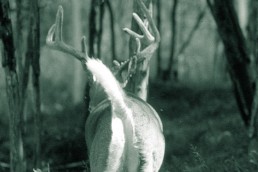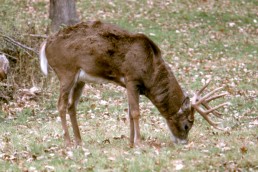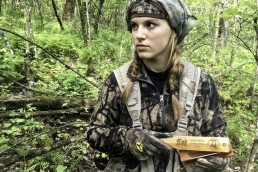True Tales about Whitetails’ Tails
SHARE THIS POST
No animal to my knowledge communicates more with its tail than a mature white-tailed deer. Such communication is not simply a matter of “tail-down,” meaning the deer is not alarmed, or “tail-up,” meaning the deer is alarmed. Recognizing a whitetail’s state of mind or what it is about to do based on whatever its tail is currently telling you can greatly contribute to your hunting success.
Take day-to-day tail communications among whitetails while danger is not near (or while a deer is unaware a hunter is near). Let’s imagine a mature, unsuspecting buck—older than an inexperienced yearling—is 20 yards away in front of where you are seated, hidden on a stool on the ground or you are up in a treestand. The buck is moving slowly from left to right, complacently feeding, with the head often down. Its tail is hanging loosely downward, meaning the deer is currently unaware anything dangerous is near.

Suddenly, its tail wags once from side to side. This indicates that the buck is about to raise its head and/or step forward. This is not a sign this deer has suddenly become aware of your presence. Other deer seeing this quick-tail wag recognize it as a sign that “all is well.”
Let’s say you don’t realize this and you immediately begin raising your bow or firearm within sight of the buck’s exposed right eye. Whitetails’ eyes are extremely sensitive to nearby motions. Predictably, that buck will see your motion and abruptly raise its head to stare in your direction. You freeze. You are well camouflaged; there is no skin on your face showing and your hands are covered. The big tree trunk at your back and branches and dense foliage behind you keep your dark silhouette from being easily recognized. The buck continues to stare at you for minutes, but you are invisible, as long as you don’t move. The deer’s tail is down, meaning it has not identified you. Suddenly, the buck wags its tail from side to side again signifying it is satisfied with believing whatever it saw moving is not dangerous. The quick wag also means the buck is about to lower its head to resume feeding.
You raise your weapon farther, but quite unexpectedly, your bow or rifle bumps a small tree branch. It wasn’t much of a bump, but whitetails have extraordinary hearing; it’s their number one way of detecting humans, wolves or bears that are stalking them. The buck raises its head and stares at you again. Your initial motion and the subsequent sound you made are now ominous. Though the buck cannot see whatever made the motion and sound, it now knows something “unusual” is in or near that tree. Squirrels and birds don’t make a bumping sound like the one you made. The buck is now especially anxious to discover what you are and where you are located. You might be a potentially dangerous human perched in the tree. The buck is also beginning to “sense” something is staring at it—a known predator is stalking it as its selected prey. The white hairs on the underside of the buck’s tail and rump are thus becoming erect and noticeably visible on each side, yet hanging downward, meaning fear is beginning to take hold in its mind. But even now it is not yet sure its alarm is justified. Its tail begins slowly rising to a horizontal position, so the buck is now becoming increasingly alarmed and is poised to flee, if necessary. The trouble is it is still undecided about whether or not it is actually in danger.
At this point, all is not yet lost if: 1) you turn your eyes to one side, keeping track of the buck via peripheral vision only, 2) you remain steadfast in your stillness and remain quiet and 3) if an errant breeze does not carry your dozens of unmistakable scents toward the buck. Subsequently, its tail will soon begin lowering and the white hairs of its rump and tail will relax and become less visible, at which point the buck is no longer alarmed. This can take up to 15 long minutes, but your chances of taking that buck will then be much improved. Keep in mind however, during the next 30 minutes that buck will remain especially alert to detecting any further movements or sounds made by you.
If you lack patience and anxiously shoulder your rifle or come to a full draw with your bow, despite being able to see one or both of the eyes of the buck before you (within 50 yards), you thus practically guarantee one of several quick responses by that deer that can have season-long consequences.
Are you enjoying this post?
You can be among the first to get the latest info on where to go, what to use and how to use it!
Unlike most other whitetails, the older bucks are likely to abruptly slip silently away, tail-down (to avoid giving you an obvious target) and take quick advantage of dense intervening cover. Generally, unless surprised at very short range, mature bucks avoid noisy bounding and snorting. They prefer quiet, controlled, rapid trotting when it is prudent to move quickly away (with hoofprints about 8 feet apart and moving along a straight line).
If it’s unsure something truly dangerous is nearby, a mature buck—or any other mature whitetail that is close—may bound away in a peculiar manner. These include short, 8-foot, unhurried jumps with its tail up but not fanned (without white hairs on its tail and rump becoming erect). Its tail will appear narrow, somewhat limp and it will wag from side to side as it moves quickly away. Not greatly alarmed, the buck will halt to assess its backtrail soon after it is out of sight. If pursuit is not evident, it may begin feeding again—if it was doing so when interrupted—within 100 yards. The buck will not abandon its range and will likely be seen again elsewhere in the same vicinity during the remaining hunting season.
Some whitetails that bound away with tails wagging might soon sneak back to the spot where they first became alarmed, overwhelmed by curiosity. This is characteristic of yearling bucks. During my 70 years of whitetail hunting, I have watched quite a few spikes or forkies make this mistake. Upon returning, some will begin hesitantly stomping the ground with their forehoof, obviously attempting to make the motionless hunter react in some way that will help reveal their identity and/or intention—some that tried this with me didn’t survive.
If a mature buck finds a reason to vacate a vicinity with all possible speed, making noisy leaps at 18 to 25 feet with the tail fully up and fanned, its white hairs of the tail and rump fully erect (making its white tail unusually large) and perhaps snorting as it goes, that buck is almost certain to quickly abandon its home or breeding range and/or become completely nocturnal throughout the remainder of the season. If not frequently alarmed by one or more hunters, yearling bucks and does of all ages are likely to return to their ranges within one to seven days.
A logical conclusion based on all the aforementioned is this: You will always be more successful at taking mature bucks or other mature whitetails (2 1/2 years or older) if you hunt in a manner which keeps whitetails from raising their tails and fleeing with all possible speed—stand-hunting, for example. The fewer bobbing whitetails that you see, the greater the number of deer that will remain in your hunting area throughout a season, doing the predictable things in predictable places during predictable hours.
Dr. Ken Nordberg has written more than 700 magazine articles and 12 books on the habits and hunting of whitetails and black bears, including the “Whitetail Hunters Almanac” series. He also produced “Doc’s Buck and Bear Hunting School” videos. His encyclopedic website is at drnordbergondeerhunting.com.
MWO
SHARE THIS POST
Did you enjoy this post?
You can be among the first to get the latest info on where to go, what to use and how to use it!
Dr. Ken Nordberg
Based on his 55 years of field research, Dr. Ken Nordberg has written more than 800 magazine articles, 12 books on whitetails—including the famous Whitetail Hunter’s Almanac series—five books on black bear hunting and produced Buck and Bear Hunting School videos. You may peruse his encyclopedic website with whitetail hunting tips: drnordbergondeerhunting.com, his blog: drnordbergondeerhunting.wordpress.com, or social media pages.


